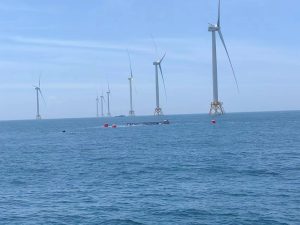The application of automatic feed machines in deep-sea aquaculture is gaining increasing attention, especially with the expansion of marine farming and technological advancements. Automated equipment plays a key role in improving aquaculture efficiency, reducing costs, and boosting productivity. Below are the main applications and advantages of automatic feed machines in deep-sea aquaculture:
1. Improving Feeding Efficiency
Deep-sea aquaculture often faces complex environmental conditions, such as water depth and current velocity, making traditional manual feeding difficult. Automatic feed machines can automatically dispense a preset amount of feed based on the specific needs of the aquaculture environment, avoiding overfeeding or underfeeding and improving feeding efficiency.
2. Reducing Labor Costs
Manual feeding in deep-sea aquaculture is not only costly but also faces challenges such as a lack of labor and harsh working conditions. Automatic feed machines can operate continuously 24/7, reducing reliance on human labor and thus lowering labor costs.
3. Precise Control of Feed Dispensing
Automatic feed machines, equipped with sensors and control systems, can precisely control the amount, time, and location of feed dispensing, preventing feed wastage and water pollution. This is especially important in deep-sea aquaculture, where water quality is difficult to recover, and precise feed control helps maintain stable water conditions.
4. Adapting to Complex Marine Environments
Deep-sea aquaculture is usually located in deeper waters where marine conditions, such as tides, water flow speed, and temperature, can vary significantly. Modern automatic feed machines are typically equipped with sensors that adapt to these conditions, automatically adjusting their operating status to ensure accurate feed dispensing.
5. Remote Monitoring and Management
Deep-sea aquaculture sites are often far from land, making manual inspections difficult. Automation systems can connect in real time with a ground control center via satellite communications and wireless transmission, enabling remote monitoring and management, and improving the intelligence level of aquaculture operations. This is critical for ensuring the proper functioning of aquaculture facilities, detecting issues promptly, and adjusting feeding strategies.
6. Data Collection and Analysis
Automatic feed machines not only dispense feed but also collect data on the aquaculture environment, feed usage, and fish growth. These data can be analyzed using big data technology to provide optimization recommendations for aquaculture, further improving productivity, predicting fish growth, and reducing resource waste.
7. Improving Fish Health
Scientific and reasonable feeding ensures that fish receive balanced nutrition, avoiding health problems caused by overfeeding or underfeeding. Automatic feed machines can precisely control the type, time, and amount of feed, helping improve fish growth rates and health while reducing the occurrence of diseases.
8. Environmental Protection
Automatic feed machines reduce feed waste and water pollution by accurately calculating the required amount of feed, minimizing human error and irrational feeding practices. This helps lessen the burden on the marine environment and maintain ecological balance.
9. Application of Haosail Machinery’s Automatic Feed Machines in the Zhangpu Offshore Wind Farm Aquaculture Project
In the Zhangpu Offshore Wind Farm Aquaculture Project, Haosail Machinery’s automatic feed machine has been applied. This project combines offshore wind power and marine aquaculture and faces the challenges of complex marine environments and the need for high automation. Haosail Machinery’s automated feed system effectively reduces feed waste and resource waste by precisely controlling feed amounts and feeding times, stabilizing water quality, and improving aquaculture efficiency.
In this project, the automatic feed machine not only optimized the feeding process but also integrated with other intelligent systems for remote monitoring and management. Through data collection and analysis, the system adjusts feeding strategies in real time, making precise feed deliveries based on different water areas and climatic conditions, significantly boosting aquaculture productivity.
Scientific Reference and Practical Application Results: Haosai Machinery’s automatic feed machines in the Zhangpu project have provided valuable research data for offshore wind farm aquaculture. Project data shows that the automated feeding system significantly reduces human intervention, enhances aquaculture efficiency, and optimizes feed utilization. Moreover, the system provides real-time feedback on water quality and farming conditions, helping farmers make timely adjustments to ensure fish health and the sustainability of the ecological environment.
Conclusion
The application of automatic feed machines in deep-sea aquaculture can greatly improve feeding efficiency, reduce labor costs, optimize feed usage, and enhance environmental management, making it an essential technology for modern marine fisheries development. Haosail Machinery’s automatic feed machines in the Zhangpu Offshore Wind Farm Aquaculture Project not only showcase the advanced nature of the technology but also provide strong support for the sustainable development of deep-sea aquaculture.
This enhanced version includes Haosai Machinery’s application in the Zhangpu project and its scientific and practical contributions to deep-sea aquaculture.


